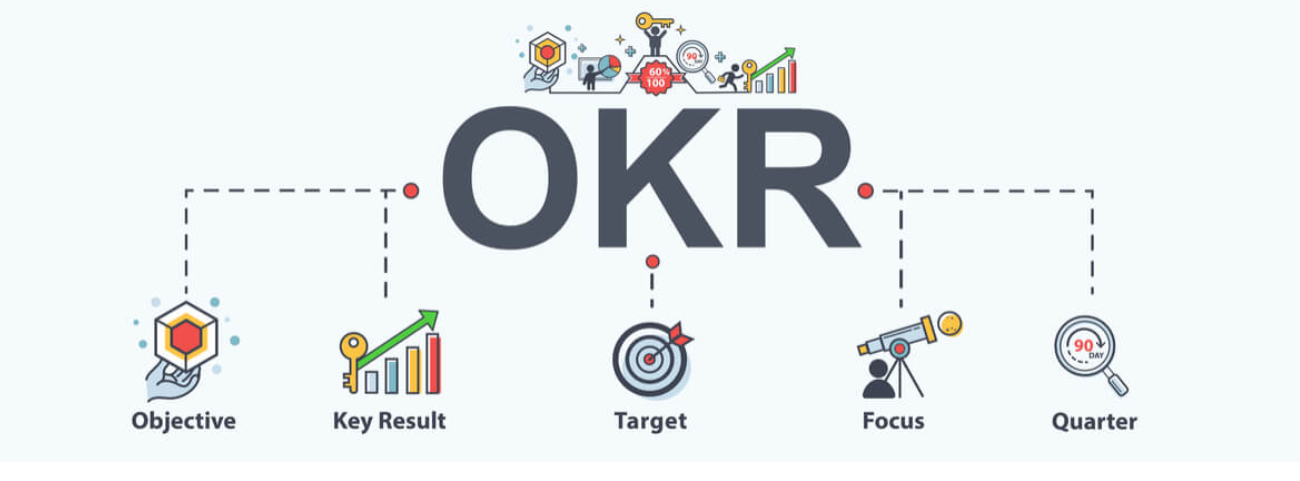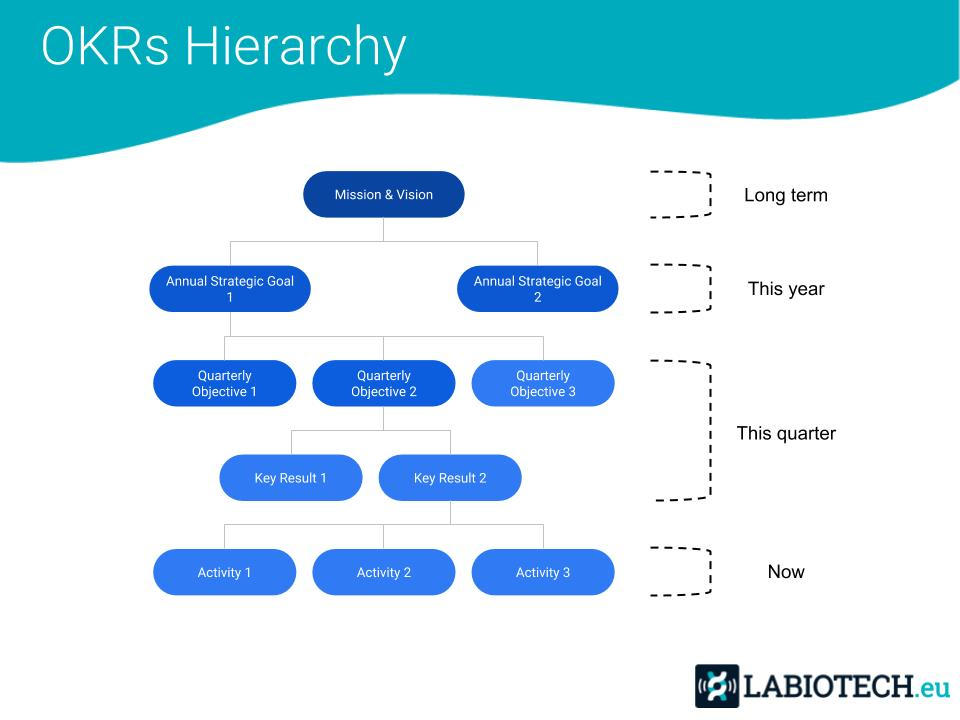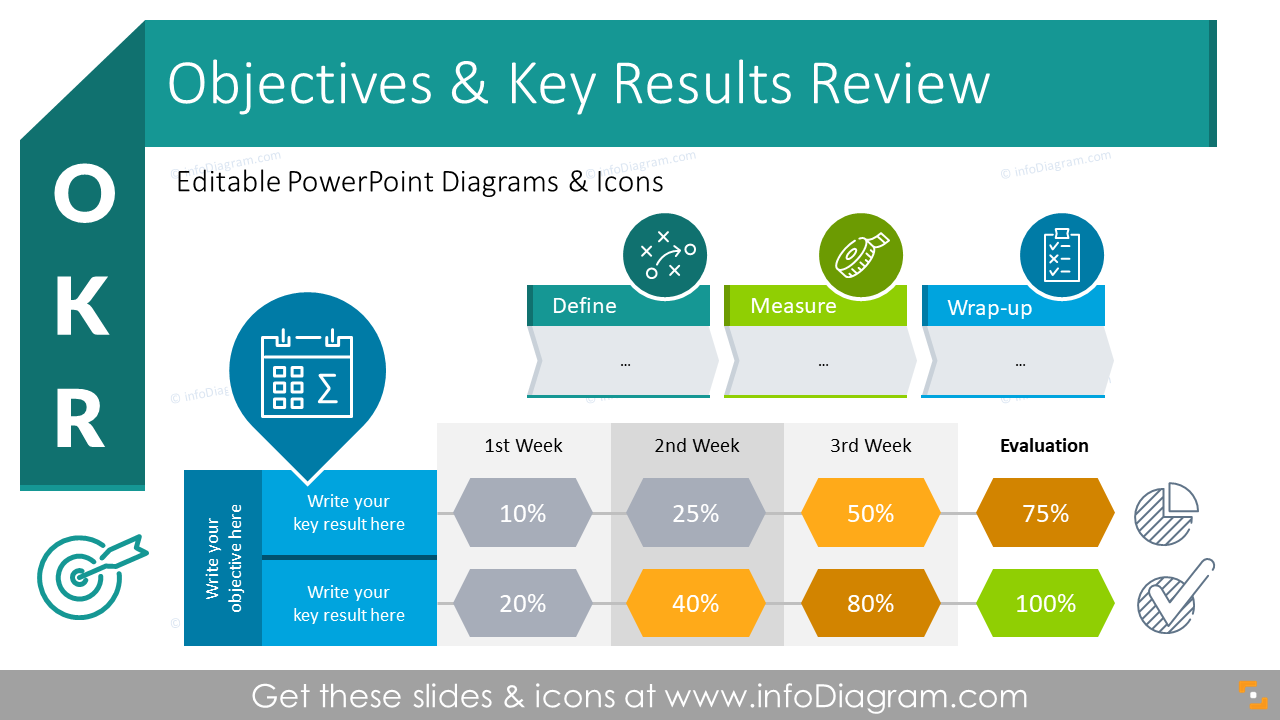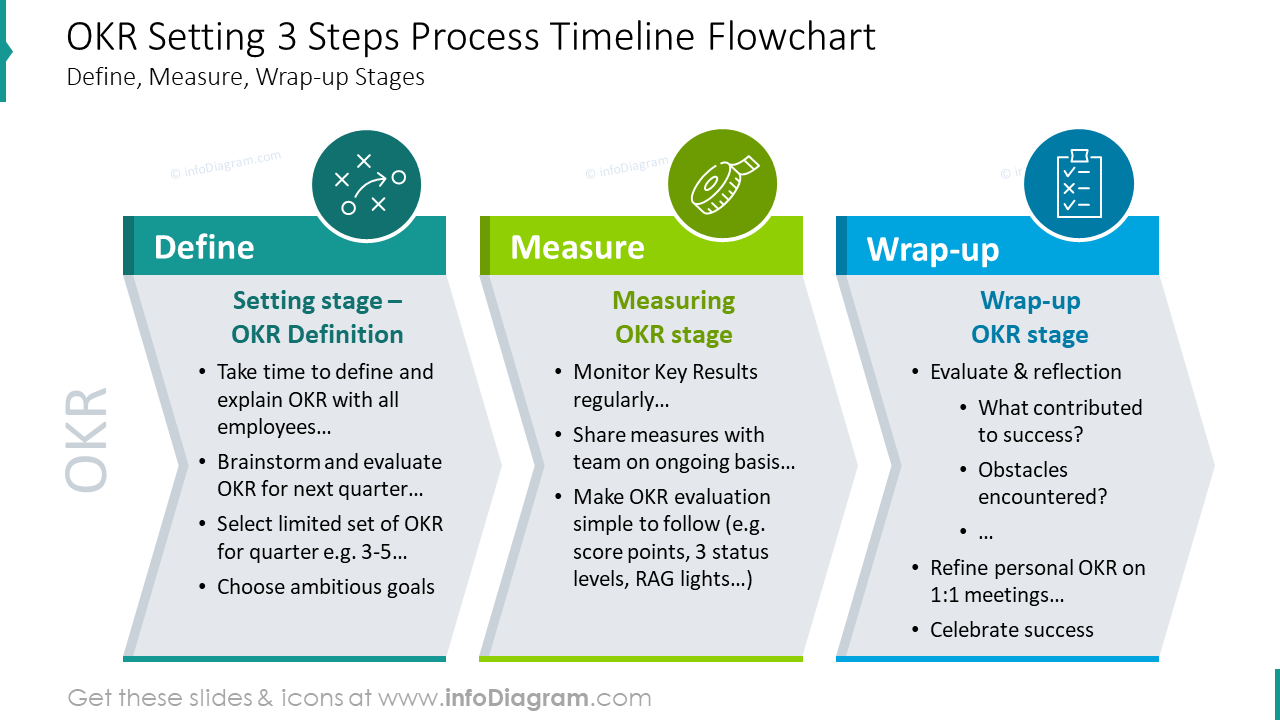Prioritising and working towards goals needs a high level of focus and alignment. One method top businesses tend to use is Objectives and Key Results (OKR). OKR helps make sure that teams and individuals are in the same place when it comes to setting targets and meeting their goals. It can also help firms keep on top of sales trends and install the latest strategies, rather than relying on outdated methods.
What is OKR?
OKR stands for Objectives and Key Results. It’s a method of setting goals that many sales and marketing teams use. Used correctly, it helps to simplify efforts and streamline practices. This framework looks at how the team end goal can be achieved using individual objectives.
For example, say an overall goal is to generate more quality leads . It might be the job of the marketing manager to create content for your specific demographic. The job of the customer service manager to make sure their team is solving customer issues. Finally, the role of the sales team to use cloud PBX services to make sure all clients have communication.
Each goal that is set needs to be achievable and measurable. These are known as key results and there should be a specific time frame in which these results can be achieved by. No more vague ‘improve customer service’ goals, but rather ‘increase recorded customer satisfaction by 20% in the next six months’.
When setting these goals, everyone on all levels must have an input on what these aims should be. Rather than handing all the responsibility to management, employees should have an active role. Not only can this help keep employees engaged and wanting to fulfil their objective, but it means any on-the-job expertise they have can be made use of. By involving everyone, you can ensure individuals at all levels will know exactly what they are doing. This will help you create world class services for your customers.

Source: Labiotech
How should OKRs be applied for optimal sales and goal outcomes?
Understanding the framework of how OKRs work will help you use it successfully. It’s important to look at the objectives, the time period and the key results.
The framework should look something like this:
Objectives
This is the result of what you are looking to accomplish. It needs to be uncomplicated, so each individual knows what they need to do. Think of it like setting up automation for business , in that however you set things up to start with will reflect on the end outcome.
Time Period
This is also something that needs to be realistic. You need enough time to work on the goal, implement it, then evaluate.
Let’s say you want to increase revenue with overseas clients. As a key result, you want to swap to video conferencing to talk to clients instead of audio-only calls. Since all this take is a simple download, you know this goal is achievable and probably won’t take long.
However, the sales team may also need to do some additional training. The marketing team may need to write a campaign around this. Tech support may need to be prepared to help people get their systems set up. Basically, you need to give things enough time to allow individuals to fulfil their goals.
Most teams give OKRs around three months as this aligns with the quarterly business calendar.

Source: Labiotech
Key Results
These are broken into three different sections that increase with difficulty. This would look something like:
- Key result one – A goal that can be measured with 80% certainty.
- KR two – A goal is that can be measured with 50% certainty.
- KR three – A goal that can be measured with 20% certainty.
Make sure to set key results that connect and make sense to each other – if you can’t do that, it may be that your objective is too large and needs breaking down.
It’s important to have a place to document how well you are doing with each goal at the end of each week. Create a chart that notes the objectives and how much you have progressed, as well as any setbacks you encountered.
Doing this will make sure that individuals keep on top of the work they need to do, as well as making it simple for management to check in. By keeping workloads organized, communication clear, and results accessible, you make it easier to monitor progress.
Examples of how to use OKR
Let’s take a look at some specific areas and examples where OKRs can help create a successful business.
Example 1: Increase sales compared to last quarter
An eCommerce business selling shoes wants to increase its quarterly revenue.
Objective: Increase sales by 10% compared to last quarter. Earn a revenue of $10,000 in this quarter.
Time period: October through December of this year.
Key results:
Launch a new product in month one and record a $2,000 increase in sales with this product.
- Sign up 10% of customers up to a paid loyalty program.
- Decrease the sales cycle from 30 days to 25 days.
Most companies tend to have an increase in sales as one of their primary objectives. Of course, the target of sales will vary from company to company and industry to industry. For example, if company A is a big firm and makes money from selling a virtual phone and fax service , their goals will be in the thousands – possibly hundreds of thousands . If company B is a small business and designs and sells handmade soap on eBay? They’re probably aiming for hundreds.
Of course, these are just targets and don’t detail the specifics. Questions like what product they’re going to launch and what the loyalty scheme will look like need to be figured out. Teams will need to figure out their roles, and what their contributions will look like.

Source: Infodiagram
Example 2: Increase sales made through customer services
A media and marketing firm wants to increase the sales made through customer services.
Objective: Increase sales through customer services by 20% up from last quarter.
Time period: From April through to June.
Key results:
- Hire more 2x more customer service staff than at the start of the business year.
- Each team member to make 30 leads a day.
- Reduce the number of leads lost by 15%
Again, relying on customer service agents to make sales is quite common in business. But it isn’t just down to this team to make sure that goals are met.
For example, introducing the best call center software , like a CRM system, will help staff keep on top of leads. This will help with key results two and three. For key result one, it’s the job of the HR department to write a job advert that will pull in the best people. The type of business you are in and the aim of your objective will alter your key results, and how you might reach them.
Example 3: Improve inbound lead processing
A telecommunications firm wants to improve their inbound lead processing.
Objective: Improve inbound lead processing by 30%
Time period: From March through to June
Key results:
- All website enquiries to be answered in less than 24 hours
- 60% of signups given product demos within 24 hours
- Make sure the company landing page has common questions answered so customers keep interested.
With this objective, various teams need to work together to get the job done. For key result one, the customer service team may have to push themselves to make sure all questions are answered in this time frame. Alternatively, it could be a good time to invest in automated customer services and use something like a chatbot to answer queries ASAP. This then becomes a job for both customer services and IT.
For key result two, both marketing and customer care will have to work together to make sure the goal is met. Marketing will bring people in whilst sales can do the actual demos.
Key result three is a job for marketing. Although, they may have to collaborate with the IT team, as well as customer services to find out what questions need answering.
Remember that in any objective you make, introducing new software can help speed up most processes. You could provide sales with an automated scheduling service, making it easier to plan demos. It could be that you give customer services a phone number forwarding service , leading to a higher number of client calls getting answered.
Modernizing the workplace with new software will help meet goals and objectives quicker.

Source: Infodiagram
Wrapping Up Objectives and Key Results
Once you reach the end of the time period, it’s time to wrap-up and evaluate. What worked and why? What setbacks did you encounter? You can use this data to set new goals, and repeat the process.
OKR is a great way of streamlining objectives by breaking down what needs doing and by when. It can provide staff with autonomy about their work, help encourage collaboration and provide clear and consistent targets.
By breaking down projects with this framework, there is a better chance of goals being reached. That means bigger profits and a better name for your firm – what more could you want?
Want to help contribute to future articles? Have data-backed and tactical advice to share? I’d love to hear from you!
We have over 60,000 monthly readers that would love to see it! Contact us and let's discuss your ideas!
